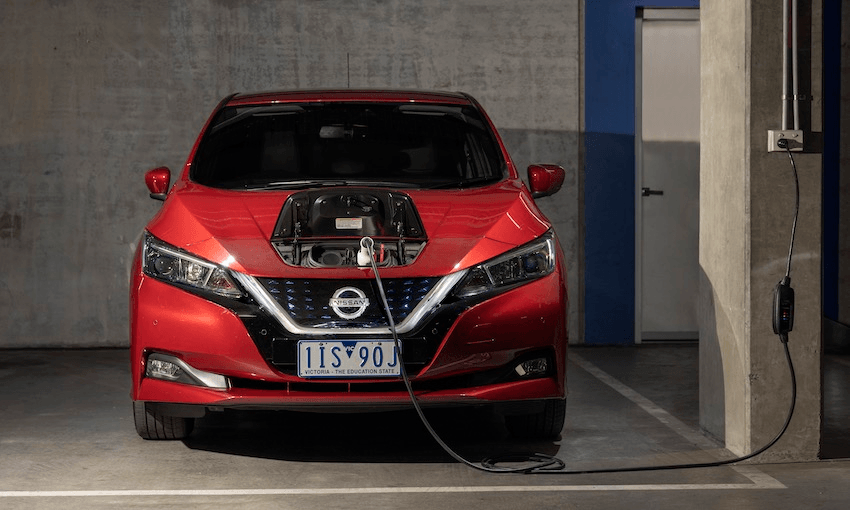Covering Climate Now: The release of the new Nissan Leaf electric vehicle signals a shift in the role of cars in our society. Simon Day was at the launch of the new model.
The Spinoff’s participation in Covering Climate Now is made possible thanks to Spinoff Members. Join us here!
According to the Ministry of Transport 90% of travel by car in New Zealand is less than 90km. The average daily travel by car is less than 29km, and in urban centres, it’s just 22km per day. Yet, the major concern New Zealanders have about electric vehicles is their range.
The obsession with range is part of a romantic vision of our car as a cruising machine built for long road trips along curling coastlines. In order to release the true potential of EVs to combat climate change, New Zealanders need to change the way we think about what our car is and what it does for us.
The true value of a new generation of electric vehicles is not as a traditional car, but as a giant battery. While the 2019 Nissan Leaf looks and feels like a car, it has the potential to be so much more. The new model is one of the first commercially available EVs that features bi-directional charging capability, meaning the car’s battery can return the energy stored in its battery to power your home, your office, or to sell back to the grid.
This capability changes the car from a resource designed primarily for short-distance transportation (that then spends the vast majority of the day parked and useless), into an energy resource that can continue to work while it’s stationary. With bi-directional charging, an EV becomes a way of storing energy and using it when it’s needed.
More than 80% of electricity in New Zealand is generated from renewable energy. But sources like solar and wind power are unpredictable and unreliable, and are not always available when needed. Because coal can be burned whenever it’s required it’s still an essential part of the grid. Bi-directional charging electric vehicles will allow renewable energy to be stored for when it’s needed.
“Bi-directional charging EVs and renewable energy will all come together and it will be an energy sharing network,” says Glenn Inkster, e-mobility division manager for TransNet NZ, an electrical equipment supplier that provides EV charging hardware.
In the not too distant future, cars will be an energy asset first, and a mobility asset second.
Many people have the misconception that what is powerful in a mechanical sense is also powerful in an electrical sense, Inkster explains. And this underestimates the potential of EV batteries as power sources.
New Zealand homes use on average 15 – 25kwh of energy every day. The new Nissan Leaf’s 40kwh battery provides more than enough fuel to get the household through an evening of cooking, washing, heat pumping and Netflix.
“An electrical vehicle driving 100km uses as much energy as your house does in one day,” he says. “They can become mobile storage banks called electric cars, take the energy when it is available and use it when it is needed. Done properly and integrated into our lives it will make the whole system more efficient.”
Transnet hopes to have the Wallbox bi-directional charging units tested and available early 2020. While the tech develops it allows for a number of futuristic hypothetical energy scenarios to feel much closer. Imagine an office with solar panels on the roof with a fleet of electric vehicles. During the day the EVs would charge using the in-house electricity generation, after the relatively short commute home the car would then be used to power the house ensuring the energy generated by the solar panels wasn’t wasted and avoiding using the grid during the highest demand (and highest prices). Then the EV returns to the office the next day to recharge. Architects and developers are already thinking about how to future proof buildings for its arrival.
The storage potential of EVs like the Leaf also creates resilience for when the grid is put under pressure. Bi-directional charging allows EVs to be used in response to events that will put the grid under extra stress. For example, as a storm approaches, like the April 2018 event that cut power to thousands of homes in Auckland, households would charge their EVs in preparation. And should they be disconnected from the grid the vehicle can be used to power the home.
Japan has led the development of the bi-directional charging technology in response to the 2011 earthquake and tsunami. Electric vehicles were vital tools to get food and aid to refugee centres, hospitals and schools as the electricity was quickly returned to parts of affected areas, while petrol-powered cars were crippled by fuel shortages. But the disconnection from the grid after the disaster also inspired Japan to examine how it could minimise the effect natural disasters have on the power supply and led to large trials of bi-directional charging and its ability to respond to natural disasters.
So, as well as reducing emissions, EV technology will provide fortification as the effects of climate change grow more intense and more common.
“A smartphone is called a ‘phone’ because this is what we have always called it. Yes, we still make phone calls on it, but we do a whole lot more with this device now,” says Inkster.
“A car will always be called a car, however, the way we use it and what we expect to get from it will completely change. We will still be able to drive it, but we will also be able to do a whole lot more.”
The author attended the launch of the 2019 Nissan Leaf courtesy of Nissan New Zealand.

